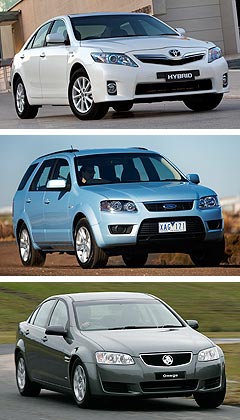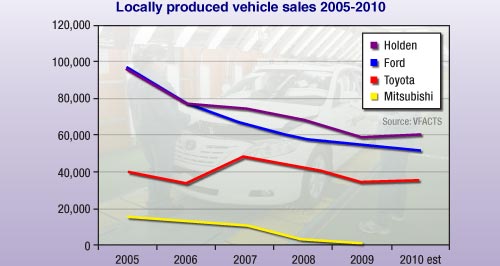Make / Model Search
News - General News - SalesSpotlight on local productionSales rocket: Holden’s popular Cruze looks set to topple Commodore as Australia’s biggest-selling locally produced vehicle when it is built in Adelaide alongside the forthcoming hatch variant. Sales of Australian-built vehicles remain stagnant, despite general industry boom15 Nov 2010 By TERRY MARTIN AS THE Australian car industry returns to a million-plus sales market this year and car companies chalk up vastly improved results after battling through the economic downturn, new registrations of locally produced vehicles remain relatively stagnant. While the new-vehicle market has climbed 13 per cent year to date, sales of locally manufactured vehicles are up just 2.7 per cent. To put things in perspective, on an annual basis sales are some 40 per cent down on the numbers achieved five years ago, when ‘Made in Australia’ sales totalled almost 250,000. Last year, that figure was down to 147,680. In 2010, most of the significant Australian-built nameplates are continuing to turn in either poor or underwhelming results. But there are some obvious exceptions to be found among each of the three remaining manufacturers.  From top: Toyota Camry, Ford Territory, Holden Commodore. From top: Toyota Camry, Ford Territory, Holden Commodore.Most notably, Toyota’s mid-sized Camry is up 18.3 per cent YTD, Ford’s Territory SUV has climbed 12.6 per cent and Holden is seeing reward for effort with its VE Series II Commodore, which has pushed sales of the large sedan and wagon range up 6.4 per cent YTD after last month recording a 9.6 per cent rise to 3787 units – its highest October sales figure since 2008. Overall, Holden is up 5.3 per cent YTD with its locally manufactured vehicles (compared to 15.3 per cent for the brand as a whole) and Toyota has seen a 4.8 per cent rise (compared to 8.1 per cent across the board), while Ford is down 1.5 per cent in terms of its local vehicles and, despite the industry resurgence, has managed only a 2.2 per cent increase YTD across its full line, imports included. For Holden in particular, these figures will improve in 2011 as it switches its source for the Cruze small sedan from South Korea to South Australia in March and, in the second half, introduces the locally designed hatchback version. The Lion brand has averaged more than 2300 Cruze sales a month this year to be up 182 per cent YTD, and once in full swing with the hatchback it should be only a matter of time before Commodore is toppled as Holden’s biggest seller and the top Australian-built vehicle. Five years ago, Holden sold around 67,000 Commodores. Last year, that figure had fallen to just over 44,000, down 13 per cent on 2008. While the company will be hoping to soon scrabble back to around 50,000 units, this is also the number Cruze is expected to rack up as early as 2012. Although Ford abandoned plans to produce its Focus small car in Australia from 2011 – which was expected to elicit at least 2000 sales a month – it, too, will be hoping for a change in sales fortunes for its Falcon sedan with the introduction of the EcoBoost four-cylinder engine. This will not, however, be launched until late-2011, nor will it be fitted to the Falcon utility for the time being, with Ford Australia focusing on its new LPi liquid-injection LPG system due for release in the ute and sedan in the third quarter. It remains to be seen how much additional sales volume the new LPG system will create for Ford, although it should at least provide a short-term boost. Ditto for the long-awaited diesel engine for Territory, due to hit the streets in the second quarter. Toyota has a new-generation Camry to look forward to, launching in the second half of 2011, followed by the hybrid version and a redesigned Aurion in 2012. Down 45 per cent last month alone, Aurion has fallen 14.9 per cent YTD with just 9600 sales so far this year, after being down 29 per cent last year (on 13,910 units) and 11.2 per cent (on 19,562) in 2008. After a 20.5 per cent decline last month, Ford’s Falcon is down 0.8 per cent YTD and is staring at another full year of around 31,000 units – five years ago that figure was 53,000 – while the Falcon ute is down 16.4 per cent YTD after last year being down 3.3 per cent for the full year (with 12,180 units), despite the federal government’s small business tax break. Although Holden’s ute is up 4.1 per cent YTD, also thanks to VEII kicking in, it was down 10 per cent last year on 12,100 units. In the mid-2000s, Holden and Ford were both selling around 20,000 locally built utes. Also consider that in 2005 Ford sold more than 23,000 Territorys. Despite this year’s gains, Ford will finish the year with around half that number. Federal and state governments have contributed large amounts of taxpayers’ money to most, if not all of, these vehicles in an effort keep the local car industry afloat. In federal funding alone, the handouts include $149 million for the local Cruze, $42m for the EcoBoost Falcon, $11.8m for the diesel Territory, $13m for Ford’s Geelong engine plant, $35m for the current Camry Hybrid and $63m for Toyota’s Altona engine plant. It is worth noting that vehicle purchases from governments, which traditionally favour local cars but have come under pressure in recent times to switch to more fuel-efficient vehicles, have fallen away dramatically in recent years. In 2005, government new-vehicle sales totalled 87,547. Last year, that figure had fallen to 60,096 and, while government sales are up 7.6 per cent in 2010 YTD, the circa-25,000 shortfall in the space of only five years has clearly had a major impact on sales of locally produced vehicles. Federal Labor’s response has been, on one level, to urge state and local governments to buy local, and on the other to help fund the production of greener vehicles, as evidenced by the $6.2 billion New Car Plan for a Greener Future, the $1.3 billion Green Car Innovation Fund and the Automotive Australia 2020 roadmap released in August. The roadmap has hybrid and electric vehicles as its core tenet for the local industry over the next 10 years, with other ‘long-term opportunities’ identified as gaseous fuels, light weight technology, and data and communications. There is, however, no evidence to suggest that the local development of new hybrids or EVs will see the graph worm turn skywards for Australian-built vehicle sales, or for exports that can offset the problems at home. As GoAuto has reported, Australians have shown little enthusiasm for purchasing hybrid cars over conventionally powered vehicles, and independent studies have shown high levels of consumer reluctance for the new wave of plug-in hybrids and electric cars.  Read more5th of November 2010  Global hybrid, EV boom ‘more hope than reality’JD Power study concludes global hybrid and EV take-up by 2020 looks to be overhyped4th of November 2010  VFACTS: Battle of the brands continuesHeat comes off new-car sales in October, but competition among brands remains fierce14th of September 2010  Holden warms up Cruze for local battleSmall car battle looms as Holden factory tools up for Cruze production |
Click to shareGeneral News articlesResearch General News Motor industry news |










Facebook Twitter Instagram